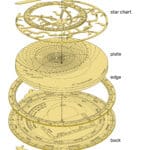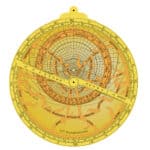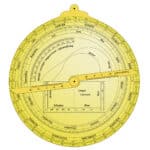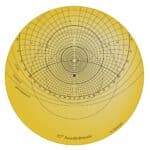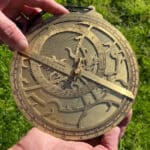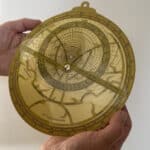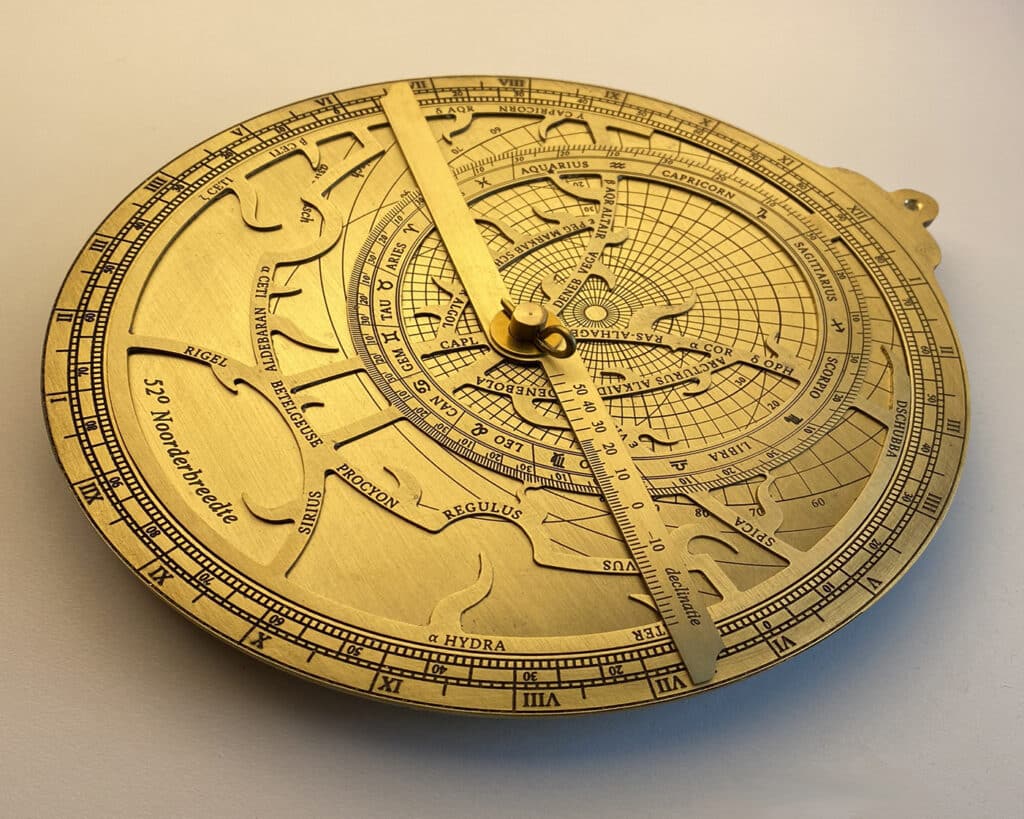
Instructions for use of the astrolabe
For the full instructions for use in Dutch click here.
General information about the astrolabe
The astrolabe is available in a brass version and in a plastic version. The functionality of both is the same.
Instructions for use of the astrolabe
On this page I explain how the astrolabe works. The examples are in a logical order. I recommend that you follow this order when mastering the astrolabe.
The components of the astrolabe
The astrolabe consists of several parts. In the first image below you can see the names of the parts as used in the examples.
- parts astrolabe
- front
- back
The area where the astrolabe operates
The plastic astrolabe works well in the Netherlands, Belgium, Northern France and Denmark. The plastic astrolabe also works well to the east and west, so for example England, Germany, Czech Republic, Slovakia, Austria, Poland, South Russia, North China, Canada and North America to name a few countries.
- plate for latitude 52 deg
The brass astrolabe is made per piece for a latitude of your choice. Contact Hendrik Hollander to discuss the possibilities.
Modern star positions and time systems
The astrolabe works for the modern star positions and sun positions. By this I mean that the position of the sun and the stars you will find with the astrolabe are the positions in the celestial sky in the 21st century. More precisely, the vernal equinox is an important reference point for describing the positions of stars in the sky. The vernal equinox shifts one degree in about 72 years. As a result, ancient astrolabes of the 15th and 16th centuries, for example, do not indicate the star positions as they occur today. The astrolabe that you received from Hendrik Hollander has been adapted to modern times, so adapted to the current location of the vernal equinox and thus indicates the current star positions.
The astrolabe also has methods to display the time of star positions or sun positions in modern time systems such as winter time or summer time in the Netherlands or other countries.
Manual
The astrolabe gives you a wealth of information about the movement of the sun and stars. To set the astrolabe on a specific date, it is important to locate the sun on the ecliptic on the date of your choice. The ecliptic is the path in the sky that the sun travels during a year. This path is divided into 12 equal parts, which are indicated by the zodiac signs. What the difference is between the signs of the zodiac and the constellations of the zodiac and how to find the position of the sun on the ecliptic for a certain date, you can read in the instructions for use below.
Find the zodiac signs of the sun
Once you have found the position of the sun on the ecliptic on the date of your choice based on the above explanation, you can now set the star chart (rete) on the front of the astrolabe at a specific time. By setting this you will find the star positions on the date of your choice and at the time of your choice.
You can read below how you can do this.
Set the start chart to a specific time and date
- instellen van het instrument
- De voorkant
You have now set the star chart to the date and time of your choice. The positions of the stars are now shown by the angle measured from north or south along the horizon and the angle of a star above the horizon. These angles are called the azimuth and altitude of a star. For example, you can see how many degrees the sun is below or above the horizon or, for example, that a certain star is a few degrees from south at an altitude of 30 degrees above the horizon. You can find out exactly how this is indicated by the astrolabe in the discription below.
Reading the position of a star
The steps, described above, are the main steps to use the astrolabe. We recommend to master the steps above before you move on to the more advanced functionality as described below.
In addition to the position of a star, you can also read the position of the sun in the sky on the astrolabe. For someone who wants to look at the stars, it is interesting to know when the astronomical twilight starts. This is the case when the sun is 18 degrees below the horizon. You can read the time that this is the case on a date of your choice in the manual below.
Astronomical dusk on a date of your choice
In the paragraphs above you have found the local solar time of astronomical dusk. However, your watch does not indicate the local solar time but for example the summer time or the winter time in the Netherlands or perhaps the time in Canada because you use this astrolabe there. How do you convert the local solar time to the time of your watch? We are in a time zone of several hundred kilometers stretched out in the east-west direction. There is also a correction that depends on the date, which is known as the equation of time. You can read how to apply all this in the following instructions for use.
Convert the local solar time to the time of your watch
A lot of functions of the astrolabe have been discussed so far. On the back of the astrolabe, two squares are present. The right square is used for the longitude correction. This is what you used in the previous example. The left square indicates how many times the length of a stick in the ground fits into its own shadow. When you do this, you read the altitude of the sun in the edge of the astrolabe, so the angle the sun is above the horizon. The other way around is also possible. If you set the height of the sun at the edge of the astrolabe, you can read how often the length of a stick in the ground fits into its own shadow in the left square. Imagine walking on the beach in the afternoon and seeing your own shadow. The following manual explains how you can find the time indicated by your watch using the astrolabe and this shadow.
- hoogte meten
Declination and right ascension
On Earth, the location of a place is indicated by its latitude and longitude. For example, a GPS gives these coordinates. A location in the celestial sky is indicated by its declination and right ascension. Right ascension is measured along the celestial equator from the vernal equinox to the place where the star's distance (angle) from the celestial equator is as small as possible. After that, a star's declination indicates how many degrees the star is above or below the celestial equator. Declination can be compared to the latitude on Earth, right ascension can be compared with longitude on Earth. How to read the right ascension and declination of a star on the astrolabe is explained in the following instructions.
Declination and right ascension of a star
Sidereal time, solar time, summer time, winter time.
We discussed a number of time systems so far. Summer time and winter time apply throughout the Netherlands. For example, at 15:30 summer time it is 15:30 summer time throughout the whole of the Netherlands. Solar time is local time. For example, if it is 11:15 solar time in Haarlem, then it is already later than 11:15 in Enschede. Solar time is defined by the position of the sun. At 12:00 solar time the sun is in the south. Sidereal time is also a local time. The sidereal time is defined with the position of the stars, at 0:00 sidereal time the vernal equinox is in the south. You can read how to find the sidereal time using the astrolabe in the following instructions for use.
If you are left with questions, do ask
So far, the basic and more advanced functions of the astrolabe are explaned. If you have any questions or perhaps you are missing a manual about a certain part of the astrolabe. Don't hesitate to contact me.
Kind regards,
Hendrik Hollander

